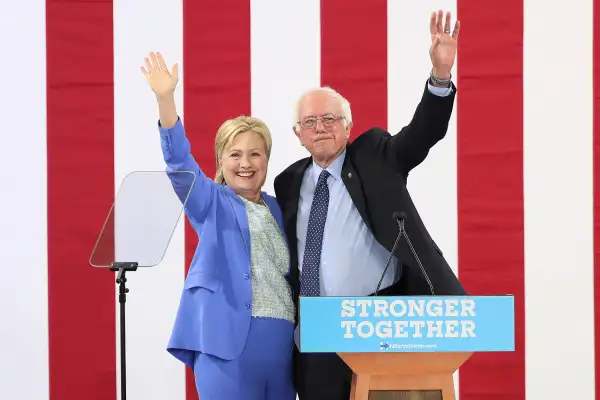It's Hillary's Party Now. Will She Make Bernie's Platform Happen?

What chance does the Democratic platform — with its bold goals on the minimum wage, college student loans, and trade pacts — have of actually becoming law? And if it did, what would be the results for you?
The prime-time program of the Democratic convention in Philadelphia kicked off Monday with Michelle Obama and the two people most conspicuously not on the ticket: Massachusetts Sen. Elizabeth Warren and Vermont Sen. Bernie Sanders. It’s an appropriate capstone to the campaign, and a kind of inverted victory lap: Yes, Sanders lost the nomination race and Warren didn’t get the vice presidential nod.
The story of the Democratic campaign, however, has been a steady drift to the left. Sanders may not be the nominee, but at this point many of his positions have been adopted (co-opted, if you want to be contentious) by Hillary Clinton. So there will be plenty of Sandersismo on display at the convention.
Some highlights and what they might mean to you:
The Fight for Fifteen: When I wrote about the $15 an hour minimum wage in late 2015, I cautioned that it was unlikely to happen any time soon. A key Bernie rallying cry, a minimum wage at that level was getting serious pushback even from liberal economists. They cautioned that such a high minimum could wipe out jobs in parts of the country where $15 an hour is pretty close to the average wage. The Obama administration was pushing for $10.10 an hour, up from the current $7.25. Hillary Clinton was splitting the difference, edging to a $12 an hour compromise.
Well, that restraint is history, at least at the Democratic convention. Fifteen dollars an hour is part of the platform. Realistically, that’s still not close to becoming law. Remember, the current administration has not been able to get Congress (read: the GOP-controlled House) to agree to $10.10 an hour. And states like New York and California that have moved to $15 have done so with long phase-ins. Note that $15 an hour would be more than double the current federal minimum.
That federal minimum has become increasingly irrelevant, since a number of states have their own (higher) levels. Fifteen dollars an hour would change that dramatically. It likely would increase wages, not just for the lowest paid, but for workers several steps up the ladder. Given the years of wage stagnation, that’s a good thing. However, what the raise would do to employment is unclear. It’s likely there would be some overall decline, but nobody knows how much.
Student Loans: The Sanders campaign was driven largely by the young, and student loans were probably the keystone issue. On this, too, the party has essentially adopted Sanders’ position. Clinton had initially pushed for more generous repayment terms on student loans. Earlier this month, she unveiled a much more dramatic proposal that would guarantee debt-free tuition for students at state universities whose families earn under $85,000 a year (phased up to $125,000 a year in 2021).
“Debt-free graduation” has the virtue of simplicity. Like other seemingly simple plans — recall President George H.W. Bush's pledge: “Read my lips, no new taxes,” which he later reversed — enacting it could bring added and perhaps unforeseen complexities. The plan is obviously very attractive in states where there are strong public universities. It would put pressure on private colleges to cut prices, too. This is something that top schools could probably do, and others might struggle with. The plan would probably clobber the for-profit college system, in which many institutions are driven almost entirely by federal student loans. Those have been the source of some of the biggest educational disappointments and student loan abuses.
The Sanders movement really took greatest hold on college campuses. You can still see hints of this in the Clinton plan. What happens to non-traditional students, who go to college part-time, or later in their careers? Are they eligible for the Clinton plan? That’s a big blank, still waiting to be filled in.
Trade: If there’s any issue on which Clinton has had to do an about-face, this is it. The party platform squirms and wriggles around the Trans Pacific Partnership, saying that “America has signed too many trade deals that have not lived up the hype,” without actually coming out against TPP. Clinton, who spent most of her political career as a free-trade advocate, now opposes TPP. So does Tim Kaine, who basically switched sides when he joined the ticket.
You’d be hard-pressed to recall that this is a trade deal negotiated by a sitting Democratic president, Barack Obama. Or that it was another Clinton who negotiated NAFTA, the North American Free Trade Agreement. On balance, for most Americans the anti-trade talk is a net economic negative. Yes, it’s possible to keep a few more manufacturing jobs in the U.S., but that probably comes with losses in other jobs.
All that said, in reality there is a lot of wiggle room here. There’s no commitment to actually quash TPP as Sanders urged — just to make it a better deal. Frankly, not many folks are likely to wade into the details on that. If you want to, you can start reading here. Be warned: Michelle Obama’s speech (or, well, anything else) is a more fun way to spend your evening.
